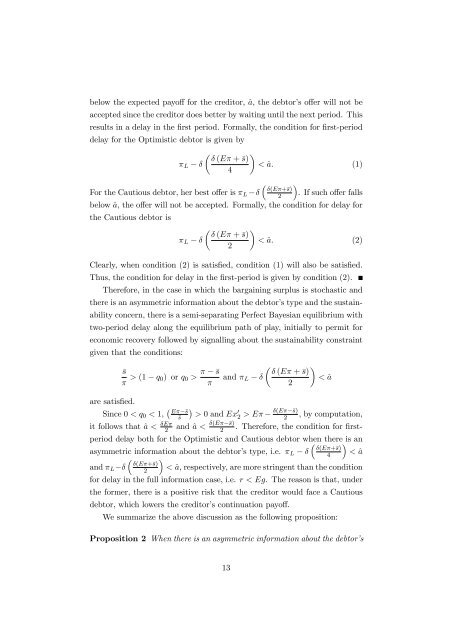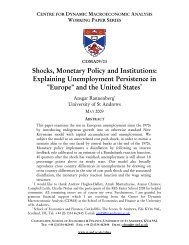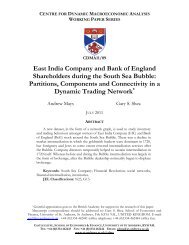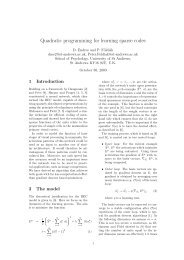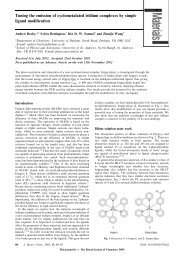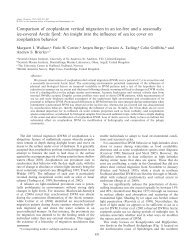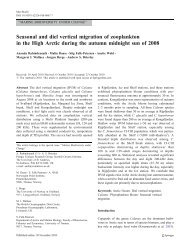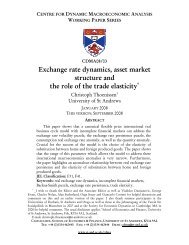Delay and Haircuts in Sovereign Debt - University of St Andrews
Delay and Haircuts in Sovereign Debt - University of St Andrews
Delay and Haircuts in Sovereign Debt - University of St Andrews
You also want an ePaper? Increase the reach of your titles
YUMPU automatically turns print PDFs into web optimized ePapers that Google loves.
elow the expected payo¤ for the creditor, ^a, the debtor’s o¤er will not be<br />
accepted s<strong>in</strong>ce the creditor does better by wait<strong>in</strong>g until the next period. This<br />
results <strong>in</strong> a delay <strong>in</strong> the …rst period. Formally, the condition for …rst-period<br />
delay for the Optimistic debtor is given by<br />
L<br />
<br />
(E + s)<br />
<br />
< ^a: (1)<br />
4<br />
<br />
For the Cautious debtor, her best o¤er is L (E+s)<br />
2<br />
. If such o¤er falls<br />
below ^a, the o¤er will not be accepted. Formally, the condition for delay for<br />
the Cautious debtor is<br />
L<br />
<br />
(E + s)<br />
<br />
< ^a: (2)<br />
2<br />
Clearly, when condition (2) is satis…ed, condition (1) will also be satis…ed.<br />
Thus, the condition for delay <strong>in</strong> the …rst-period is given by condition (2).<br />
Therefore, <strong>in</strong> the case <strong>in</strong> which the barga<strong>in</strong><strong>in</strong>g surplus is stochastic <strong>and</strong><br />
there is an asymmetric <strong>in</strong>formation about the debtor’s type <strong>and</strong> the susta<strong>in</strong>ability<br />
concern, there is a semi-separat<strong>in</strong>g Perfect Bayesian equilibrium with<br />
two-period delay along the equilibrium path <strong>of</strong> play, <strong>in</strong>itially to permit for<br />
economic recovery followed by signall<strong>in</strong>g about the susta<strong>in</strong>ability constra<strong>in</strong>t<br />
given that the conditions:<br />
s<br />
> (1 q 0) or q 0 > s<br />
<br />
<strong>and</strong> L<br />
<br />
(E + s)<br />
<br />
< ^a<br />
2<br />
are satis…ed.<br />
<br />
E s<br />
S<strong>in</strong>ce 0 < q 0 < 1,<br />
s > 0 <strong>and</strong> Ex<br />
0 (E s)<br />
2 > E<br />
2<br />
, by computation,<br />
it follows that ^a < E<br />
(E s)<br />
2<br />
<strong>and</strong> ^a <<br />
2<br />
. Therefore, the condition for …rstperiod<br />
delay both for the Optimistic <strong>and</strong> Cautious debtor when thereis an<br />
asymmetric <strong>in</strong>formation about the debtor’s type, i.e. L (E+s)<br />
4<br />
< ^a<br />
<br />
<strong>and</strong> L (E+s)<br />
2<br />
< ^a, respectively, are more str<strong>in</strong>gent than the condition<br />
for delay <strong>in</strong> the full <strong>in</strong>formation case, i.e. r < Eg. The reason is that, under<br />
the former, there is a positive risk that the creditor would face a Cautious<br />
debtor, which lowers the creditor’s cont<strong>in</strong>uation payo¤.<br />
We summarize the above discussion as the follow<strong>in</strong>g proposition:<br />
Proposition 2 When there is an asymmetric <strong>in</strong>formation about the debtor’s<br />
13


